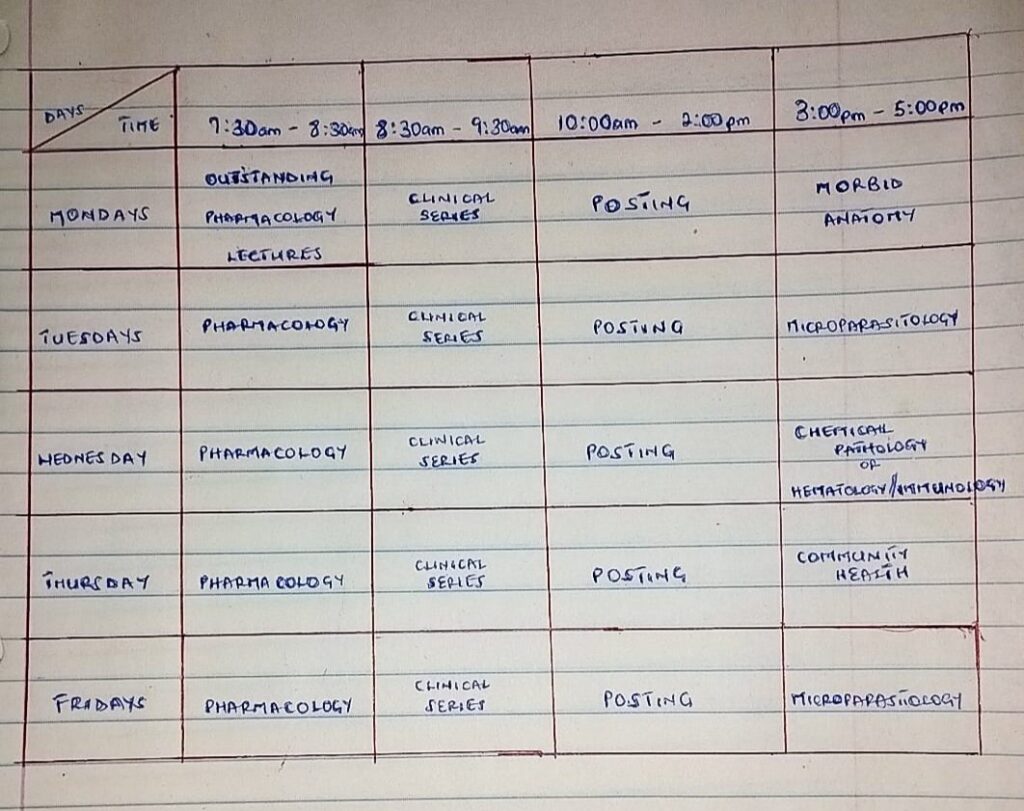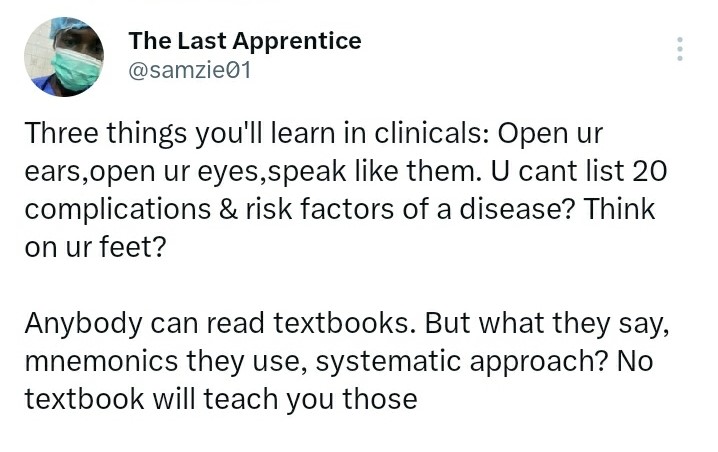Alternative title: Clinical 1 Starter Pack
Clinical 1! The beginning of the apprenticeship year and your first real opportunity to pretend to be a doctor. It’s a new and exciting challenge. Years of cramming and forgetting the Kreb cycle are over. What you’re about to read is an intro guide to Part 4 and a glimpse into what your life is going to be like for the next 12+ months.
Quick Disclaimer: I wrote this guide for the class that is coming into Part 4 in the next 3 months. It is not meant to be comprehensive, but you will get the picture.
Commencement of lectures in Biostats, Behavioural Sciences and Community Health signals the beginning of the new class. Most students tend to blow off these lectures. You may want to think twice before doing that. There is an end-of-lectures exam which will form part of your C.A. in Part 6.
Part 4 proper begins with your Path and Pharm lectures along with the clinical postings. However, this doesn’t start until the old part 4 (Part 4A) leaves the class. (lesson: you don’t bounce your seniors in medical school).
The first thing you should know and brace yourself for is that clinical 1 is a 2-in-1 class. Four hours of classroom lectures alternating with 4 hours of clinical postings. Everyday. For the whole year. It is nothing like any class you’ve been in. The rigorous schedule beats everything you ever faced in preclinicals. The workload is crazy. Financially? Demanding.
Also, get ready to write letters. Official letters. If you stab classes; if you miss certain postings. Letter of permission. Letter of apology. Even letter of explanation.
1. What you need and what you should get
2. Should you read before resumption?
3. A typical week in clinical 1
4. Postings & Grouping
5. Folders, Notes, Links, PQs
6 The grading system
WHAT YOU NEED AND WHAT YOU SHOULD GET
By now you already know that your ward coats and scrubs are the first set of things you absolutely need to have ready before resumption. The ward coat is similar to (but not the same as) your lab coats. It is best to sew an actual ward coat.
Name tags (for postings) and matric tags (for oral exams).
You must have gotten a forwarded message on your class page containing the recommended textbooks for each course and the alternatives. It is important to get these texts (and read them). If you ask, senior colleagues are usually more than happy to hand down their textbooks and materials.
For things like stethoscope & pen torch, it is good to have yours.
SHOULD YOU READ BEFORE RESUMPTION?
The answer is yes. Senior colleagues will tell you to cover the first 7 chapters of Robbins and Cotran. And the entire general pharmacology in Katzung. Between you and me, that is highly unlikely except you’re a jackophyte. But please read ahead.
A WEEK IN CLINICAL 1

PHARMACOLOGY
Adjusting to the 7:30 am pharmacology class may be a little difficult—honestly, I’ve spent 11 months in this class and I’m still not fond of waking up 6:30 every morning.
Pharmacology runs for the entire session.
The first incourse tests your knowledge of basic pharmacology. It gets hectic after first incourse. And you may not even find your bearing after that.
CLI (pronounced C. L. I.)
Putting the CLI series classes immediately after pharmacology was a smart idea by whoever designed the Part 4 lecture schedule. This is because, unlike pharmacology, CLI does not have exams. Besides, the attendance doesn’t carry marks either. Hence, students don’t take the lectures seriously. This is a terrible mistake of course. These lectures may never be taken again and they will be made reference to in Part 6. CLI series lectures tie pathology, pharmacology with history taking and how to arrive at a diagnosis in medicine. It is essentially the theoretical aspect of what you will see and do in the postings.
MORBID ANATOMY
When people mention pathology, morbid is what comes to mind first. It is the bulkiest and stuffiest of the 4 pathology courses. Midway through basic pathology, Dr Adefidipe is going to take your class; don’t miss that class.
Materials will be released by lecturers but these are of little help. You are expected to read the recommended text: a voluminous textbook called Robbins & Cotran. Well, reading Robbins and Cotran may not be sustainable if you intend to cover everything. People read alternatives like Review of Pathology and Timothy Pathology.
MICROBIOLOGY AND PARASITOLOGY
The course comes up twice a week in the first half of the year. In the second half, Immunology takes its Tuesdays slot.
Micropara can be a boring course. Jawetz and Made Ridiculously Simple (which makes the course fun reading) are the popularly used texts
The lecture materials and paying attention in class are usually enough to do well.
Chemical Pathology lectures hold every Wednesday and the whole course outline is concluded by the end of the first half of the session. Haematology replaces it.
Community health holds every Thursday.
YOUR POSTING GROUP AND YOUR NEW FAMILY
Another peculiarity of the class is the fact that you get broken up into smaller groups for your postings. Each posting is unique and the best way to go about it simple. Ask about the posting you have next from those that just rotated the posting. Ask senior colleagues if your group is the first to rotate the posting.
Once lectures enter full gear, everybody disperses and you may not see your classmates for months on end. But your group members will always be there. Everyday in posting.
Don’t isolate yourself from them. These are your new family; your ticket to surviving the shege of part 4.
FOLDERS, NOTES, LINKS, PQs
Ask for the ‘Part 4 folder’ from immediate senior colleagues. That folder has been passed down several sets. It may seem a bit unorganized, but it contains invaluable resources. However, I will advise against using the presentation slides in the folder; they are extremely old.
“Molecule” is a jotting from Chem Path posting by Dr Molecule of the Excelsiors class. It is extremely helpful for Chem Path EOP.
Kaplan and pathoma videos will help you alot.
Posting & class jottings from senior colleagues and classmates are lifesavers. They give you what you need and save you the stress of sweating through textbooks.
THE GRADING SYSTEM
Nobody really knows. If anyone gives you a score breakdown, believe it at your own risk. What we are sure of, however, is that each End of Posting exam (EOP) carries an untouchable 5 marks. Pathology Incourses carry a lot less marks (some say 2.5 or even 1.25). This means your EOPs are your priority when permutating.
Pharmacology is a bit different. Each Incourse carries a significant mark.
Some say first and second incourses each carries 20 marks. Others say second incourse is 10 marks. See? No one really knows. Attendance is 5 marks though, unless your class commits an offence serious enough to make the HOD scrap the mark. And it has no EOP.
Community health EOP is a continuous assessment and takes a good percentage (about 20%) of your final examination in Part 6. Same goes for medicine and surgery EOPs.
General Advice:
1. Delete words like “You” and “I” from your vocabulary (The doctors hate them).
2. Get a space in Gloryland if you can.
3. Form a discussion group (preferably with those in your posting or hostel).
4. Be humble enough to learn from everybody.
5. Observership, Showmanship and Applying yourself. This is the holy trinity of clinicals.

This is going to be your first truly overwhelming class in medical school. You’ll get locked out of pharmacology class. You will get percussed and dazed. You’ll flap and trek. You’re going to stand till your back muscles give way in wardrounds. You will recycle slides. You will cook clerking. These are what makes the class fun. Take it all in. Later, I will provide an in-depth survival guide touching on the peculiarities of each posting.
Welcome to the other side.
To check out other Med School Lifestyle pieces, click here.



Leave a Reply